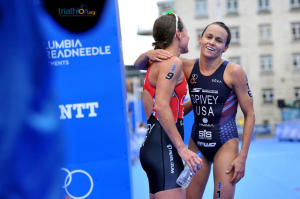Taylor Spivey grew up as a pool and surf swimmer in a swim family. (It took awhile for Taylor to outswim her mother.) But it’s a question now whether, in the context of ITU racing, the swim is Taylor’s best event.
Every accomplished ITU racer is a good swimmer and most, unlike Taylor, have a strong youth run pedigree. Relatively few develop into natural cyclists. Those who do often move to pure cycling (Kristin Armstrong, Emma Pooley). Some stay in triathlon and pummel their competition on the bike, like Flora Duffy.
Any great swim-run triathlete can become a strong cyclist. But very few become natural cyclists. Taylor Spivey looks like she might be one. Taylor’s breakthrough race was in Leeds last year, where she was part of a pack of 4, and soloed in 2nd at the finish line (to, of course, Flora). In Bermuda this upcoming weekend racers will face Corkscrew Hill 10 times, on a course made for homegirl Flora Duffy, but any course for Flora is a course for Taylor.

Slowtwitch: The WTS season kicks off in Bermuda, and I was out there a few months ago and checked the course. You were drawn into the Florda Duffy vortex on that tough ITU Leeds bike course last year and had a breakthrough race. Have you noodled the Bermuda bike course profile?
Taylor Spivey: At Leeds the stars aligned. I think Bermuda will be comparable. There is a punchy hill that we have to climb 10 times, however it looks slightly less technical. Both hilly and tech courses suit my strengths, and I look forward to burning some legs. Mine included.
ST: The American women are really strong. Obviously. And deep. And when I look at the results I see that, besides Katie Zafares, we have Summer Cook, Kirsten Kasper, Renee Tomlin, Chelsea Burns, and you. And, honestly, Summer and Kirsten are more often on World Cup podiums than you. But then there was that race in Leeds. Do you think you have an edge on hilly and hard bike courses?
TS: All of them are former swimmers and collegiate runners, and ridiculously fast. I’m the outlier. I swam in college, with a focus on academics, and never fathomed land sports. World Cups suit the runner because packs never separate much early on. These women are well rounded and able to capitalize on their running speed on the World Cup platform. Last year I surprised myself with a fast run to earn silver a few times.

ST: You came up as a swimmer. You were a 5-flat 500 yard freestyler, at Cal Poly SLO, and I take that to mean that you really don’t need to worry much about the swim. You grew up as a surf swimmer, so I can only imagine you pray for large surf and strong side currents. Do you think the ITU actively avoids surf swims, or are there many surf opportunities for someone like you who has those skills?
TS: If it were up to me, every race would be a run-in beach swim with surf. It makes the swim more tactical and exciting. Not everyone is comfortable in the surf, and race organizers need to have athlete’s safety in mind. Especially since the ITU races coincide with an amateur race.
ST: I didn’t study the New Plymouth World Cup held a couple of weeks ago in New Zealand, but it looked to me like you might’ve picked up your run between last year and this. In fact, maybe there was a glimpse of this in Miyazaki, the last race of the season last year. I don’t know. Talk running to me.
TS: Running is a new game for me, that I’m constantly trying to wrap my head around. I haven’t quite figured it out yet, but I was able to string along some decent runs last year. I like to think I will carry the momentum into this season.

ST: You went to school to be an architect. Yes? Which I think SLO is kind of known for? Are you doing any architecting? Or is that back burnered?
TS: Architecture has taken a hiatus while I currently race the WTS circuit. Every once in a while when I’m not completely smashed from training I tackle a creative project.
ST: Where are you headquartered? Who is coaching you? Who are you training with?
TS: I’m currently based in Carlsbad, San Diego, with the Triathlon Squad, coached by a man in a bright orange shirt, Paulo Sousa. Soon we will migrate to Europe to race and for an altitude stint. My training group has grown quite a bit in the last year. We total 18 right now, half American and half International athletes.
ST: Are you a tech geek? What bike are you riding? What parts? And what shoes are you running in? How do you go about making these decisions? Or do you ride and run in and on whatever they put you on?
TS: I prefer clean thoughtful products with intentional clean design. My preference to specific aesthetics and functionality were engrained throughout my architecture education.
The last two years USAT’s support from Quintana Roo never let me down in a race. No technical failures, no problems. Since my introduction to running, I have only run in Skechers Performance and have loved them since day one. One of the biggest game changers to my racing was nutrition. I couldn’t stomach a gel in race until I was introduced to Science In Sport’s Isotonic Gels. Ever since I’ve eliminated my stomach issues when running off the bike.



